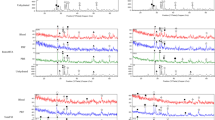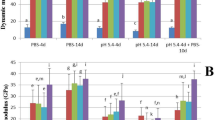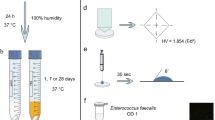Abstract
Objectives
The purpose of the present study was to evaluate the effects of human blood on the setting and microhardness of calcium silicate cements.
Materials and methods
Three types of silicate-based cements were used: ProRoot MTA (PMTA), OrthoMTA (OMTA), and RetroMTA (RMTA). Mixed cement was placed into polyethylene molds with lengths of 2 and 4 mm. After storage for 4 days under three different storage conditions, i.e., saline, saline after 5 min of human blood, and human blood, the polyethylene molds were removed. With the specimens set, the surface microhardness was measured using a Vickers microhardness tester, crystalline structure was analyzed with X-ray diffraction (XRD), and the surface characteristics were examined with scanning electron microscopy (SEM).
Results
All specimens of 4 mm in length were set with all materials, and the blood groups exhibited lower microhardnesses than did the saline groups (p < 0.05). Among the 2-mm specimens that were stored in blood, the numbers of specimens that set were significantly different across the materials (p < 0.001). Regarding the microhardnesses of the RMTA and OMTA groups, there were no significant differences between storage conditions. For the PMTA group, only one specimen that was set in the blood group exhibited reduced microhardness. XRD showed changes of crystalline structure in the PMTA and OMTA blood group, whereas RMTA did not. SEM analysis revealed more rounded and homogeneous structures and demonstrated a clear lack of acicular or needle-like crystals in the PMTA and OMTA blood groups, while RMTA did not reveal substantial differences between the saline- and blood-stored groups.
Conclusion
Blood contamination detrimentally affected the surface microhardnesses of all materials; furthermore, among the 2-mm specimens, blood contamination interfered with normal setting. Therefore, RMTA might be a more suitable choice when blood contamination is unavoidable due to limited depth.
Clinical relevance
RetroMTA might be a more suitable choice in situations in which blood contamination is unavoidable.




Similar content being viewed by others
References
Lee Y-L, Lee B-S, Lin F-H, Yun Lin A, Lan W-H, Lin C-P (2004) Effects of physiological environments on the hydration behavior of mineral trioxide aggregate. Biomaterials 25(5):787–793
Camilleri J, Montesin FE, Brady K, Sweeney R, Curtis RV, Ford TRP (2005) The constitution of mineral trioxide aggregate. Dent Mater 21(4):297–303
Torabinejad M, Parirokh M (2010) Mineral trioxide aggregate: a comprehensive literature review—part II: leakage and biocompatibility investigations. J Endod 36(2):190–202
Torabinejad M, Ford TRP, McKendry DJ, Abedi HR, Miller DA, Kariyawasam SP (1997) Histologic assessment of mineral trioxide aggregate as a root-end filling in monkeys. J Endod 23(4):225–228
Parirokh M, Torabinejad M (2010) Mineral trioxide aggregate: a comprehensive literature review—part I: chemical, physical, and antibacterial properties. J Endod 36(1):16–27
Zhu Q, Haglund R, Safavi KE, Spangberg LS (2000) Adhesion of human osteoblasts on root-end filling materials. J Endod 26(7):404–406
Parirokh M, Torabinejad M (2010) Mineral trioxide aggregate: a comprehensive literature review—part III: clinical applications, drawbacks, and mechanism of action. J Endod 36(3):400–413
Torabinejad M, Chivian N (1999) Clinical applications of mineral trioxide aggregate. J Endod 25(3):197–205
Torabinejad M, Higa RK, McKendry DJ, Pitt Ford TR (1994) Dye leakage of four root end filling materials: effects of blood contamination. J Endod 20(4):159–163
Montellano AM, Schwartz SA, Beeson TJ (2006) Contamination of tooth-colored mineral trioxide aggregate used as a root-end filling material: a bacterial leakage study. J Endod 32(5):452–455
Tingey MC, Bush P, Levine MS (2008) Analysis of mineral trioxide aggregate surface when set in the presence of fetal bovine serum. J Endod 34(1):45–49
VanderWeele RA, Schwartz SA, Beeson TJ (2006) Effect of blood contamination on retention characteristics of MTA when mixed with different liquids. J Endod 32(5):421–424
Nekoofar MH, Oloomi K, Sheykhrezae MS, Tabor R, Stone DF, Dummer PM (2010) An evaluation of the effect of blood and human serum on the surface microhardness and surface microstructure of mineral trioxide aggregate. Int Endod J 43(10):849–858
Nekoofar MH, Davies TE, Stone D, Basturk FB, Dummer PM (2011) Microstructure and chemical analysis of blood-contaminated mineral trioxide aggregate. Int Endod J 44(11):1011–1018
Salem Milani A, Rahimi S, Froughreyhani M, Vahid Pakdel M (2013) Effect of blood contamination on marginal adaptation and surface microstructure of mineral trioxide aggregate: a SEM study. J Dent Res Dent Clin Dent Prospects 7(3):157–163
Kim Y, Kim S, Shin YS, Jung IY, Lee SJ (2012) Failure of setting of mineral trioxide aggregate in the presence of fetal bovine serum and its prevention. J Endod 38(4):536–540
Dentsply (2010) ProRoot® MTA Directions for Use.
Kim Y, Lee C-Y, Kim E, Jung I-Y (2011) Failure of orthograde MTA filling: MTA wash-out? J Korean Acad Conserv Dent 36(6):510–514
Kim H-Y (2014) Statistical notes for clinical researchers: two-way analysis of variance (ANOVA)-exploring possible interaction between factors. Restor Dent Endod 39(2):143–147
Hachmeister DR, Schindler WG, Walker 3rd WA, Thomas DD (2002) The sealing ability and retention characteristics of mineral trioxide aggregate in a model of apexification. J Endod 28(5):386–390
Valois CRA, Costa Jr ED (2004) Influence of the thickness of mineral trioxide aggregate on sealing ability of root-end fillings in vitro. Oral Surgery, Oral Medicine, Oral Pathology, Oral Radiology, and Endodontology 97(1):108–111
Gilman JJ (1997) Chemical and physical "hardness". Mater Res Innov 1(2):71–76
Coleman NJ, Nicholson JW, Awosanya K (2007) A preliminary investigation of the in vitro bioactivity of white Portland cement. Cem Concr Res 37(11):1518–1523
Lee YL, Lee BS, Lin FH, Lin AY, Lan WH, Lin CP (2004) Effects of physiological environments on the hydration behavior of mineral trioxide aggregate. Biomaterials 25(5):787–793
Chang SW, Baek SH, Yang HC, Seo DG, Hong ST, Han SH, et al. (2011) Heavy metal analysis of ortho MTA and ProRoot MTA. J Endod 37(12):1673–1676
Kim E, Song JS, Jung IY, Lee SJ, Kim S (2008) Prospective clinical study evaluating endodontic microsurgery outcomes for cases with lesions of endodontic origin compared with cases with lesions of combined periodontal-endodontic origin. J Endod 34(5):546–551
Walsh RM, Woodmansey KF, Glickman GN, He J (2014) Evaluation of compressive strength of hydraulic silicate-based root-end filling materials. J Endod 40(7):969–972
Wang W-H, Wang C-Y, Shyu Y-C, Liu C-M, Lin F-H, Lin C-P (2010) Compositional characteristics and hydration behavior of mineral trioxide aggregates. Journal of Dental Sciences 5(2):53–59
Nekoofar MH, Stone DF, Dummer PM (2010) The effect of blood contamination on the compressive strength and surface microstructure of mineral trioxide aggregate. Int Endod J 43(9):782–791
Namazikhah MS, Nekoofar MH, Sheykhrezae MS, Salariyeh S, Hayes SJ, Bryant ST, et al. (2008) The effect of pH on surface hardness and microstructure of mineral trioxide aggregate. Int Endod J 41(2):108–116
Camilleri J (2007) Hydration mechanisms of mineral trioxide aggregate. Int Endod J 40(6):462–470
Kellum JA (2000) Determinants of blood pH in health and disease. Crit Care 4(1):6–14
Gandolfi MG, Iacono F, Agee K, Siboni F, Tay F, Pashley DH, et al. (2009) Setting time and expansion in different soaking media of experimental accelerated calcium-silicate cements and ProRoot MTA. Oral Surg Oral Med Oral Pathol Oral Radiol Endod 108(6):e39–e45
Author information
Authors and Affiliations
Corresponding author
Ethics declarations
Conflict of interest
The authors declare that they have no competing interests.
Funding
This research was supported by Basic Science Research Program through the National Research Foundation of Korea (NRF) funded by the Ministry of Education (2015R1D1A1A09057552).
Ethical approval
This article contains study with human participants. Approval for this project was obtained from the Yonsei University Committee for Research on Human Subjects (2014–0024).
Informed consent
For this study, informed consents for human blood collection were acquired.
Additional information
Dr. Minju Song and Wonyoung Yue contributed equally to this work as first authors.
Rights and permissions
About this article
Cite this article
Song, M., Yue, W., Kim, S. et al. The effect of human blood on the setting and surface micro-hardness of calcium silicate cements. Clin Oral Invest 20, 1997–2005 (2016). https://doi.org/10.1007/s00784-015-1693-z
Received:
Accepted:
Published:
Issue Date:
DOI: https://doi.org/10.1007/s00784-015-1693-z




